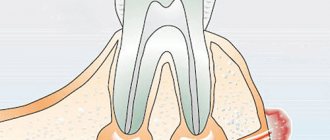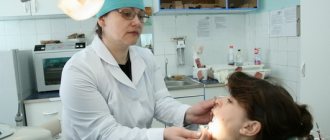Pimples on the gums are partial, compacted areas that are white in color. They have different origins.
They may have a dense or softened consistency and contain pus. Very often they pose a serious danger, especially if professional treatment is not carried out in a timely manner. The formation of an inflammatory disease will lead to tooth loss.
Important! It is prohibited to perform unprofessional medical procedures on pimples; this will lead to suppuration and increase in size.
Causes of formations on the gums
Patients call most lumps on the gums pimples. All these formations can have different contents, shapes and consistency. There are also many reasons for the appearance of such acne.
Untimely treatment can lead to tooth loss. Completely ignoring the problem can cause death. The accumulation of pus near the most important blood vessels and near the brain does not bode well. Therefore, if even a small white pimple appears on the gum, you should consult a dentist.
There is no need to be afraid of visiting the dentist. In most cases, the doctor will prescribe drug therapy and monitor the changes occurring in the lump. Perhaps the pimple will resolve on its own.
Most often, medicinal rinses and antibiotics or antifungal drugs are prescribed. Only if these measures are ineffective can surgery be used.
Possible complications
You should not assume that pimples that appear are harmless and will not cause trouble. They cannot be heated, squeezed out, or subjected to mechanical stress.
This will lead to an increase in germs, and the infection will spread quite quickly. Small children often suffer from them, so parents need to be attentive: carefully examine them, monitor their personal hygiene.
Something to remember! A small, inconspicuous pimple will eventually develop into an abscess, and it will damage not only the oral cavity, but also the brain, and this is very scary!
Wen
If a white pimple appears on the gum, it may be a wen. This formation is benign and is rare in the oral cavity. The compaction consists of adipose tissue. Its size can reach 2.5 cm in diameter.
Wen are usually painless, have a soft surface and fit quite tightly to the gum. This seal does not cause discomfort. In some cases, a person may feel as if something is stuck to the gum while eating. But most often the formation does not make itself felt and is not detected immediately.
The development of a wen can be provoked by constant trauma to the gums. For example, if a prosthesis or brace was installed incorrectly. Endocrine diseases may also be the cause. Heredity plays a big role.
When a wen is detected, the doctor first observes it. Often such seals begin to decrease in size on their own and completely resolve. Surgical removal of the wen is necessary if it increases in size. And also if the seal is often damaged. This can provoke its degeneration into a malignant tumor.
Diagnostics
It is forbidden to open tumors on your own
A mandatory dental examination will be required.
He will conduct a comprehensive check, find out what diseases are present, and prescribe the appropriate procedure.
If the pimple increases in size, it can be conservative (use of ointments, antiseptics or antibiotics) or surgical.
To identify character, you will need:
- Examination of the patient.
- X-ray examination.
- For specific infections - taking tissues for analysis.
Education occurs through the following:
- Cold.
- For stomatitis.
- Fungal gum diseases.
- Poorly performed oral hygiene.
- Allergic reaction.
- Penetration of infection.
- Mechanical damage.
It is forbidden to open tumors. Before visiting a doctor, you can rinse your mouth with chamomile infusion.
Cyst
A white lump on the gum may be a cyst. It has a round or oval shape and can reach several centimeters in size. The inside of the cyst is filled with purulent masses.
This formation begins its development inside the gum, near the tooth root. The disease is very insidious. At the initial stage it is almost impossible to detect. Only an x-ray can indicate to the dentist that a cyst is developing inside.
Until the formation is visually invisible and a pimple with a white head appears on the gum, the following symptoms will help to suspect a cyst:
- It is difficult to open your mouth wide.
- When biting hard food and during the chewing process, slight unpleasant sensations occur inside the gums.
- A feeling of heaviness at the base of the tooth.
- General weakness.
- Temperature increase.
- Enlarged lymph nodes.
- Periodic pain develops into constant pain.
The factor that provokes the development of this type of abscess, in most cases, is infection in the root canals. The main reasons include:
- Advanced form of caries. Without treatment, inflammation may develop in the upper part of the root, and a gradual accumulation of pus occurs. Trying to find a way out, it forms a cyst.
- Channels that were incorrectly sealed. If the dentist made a mistake during treatment, an infection may develop. This happens if the canal has not been completely filled with filling material. Bacteria begin to accumulate in the empty space. Sooner or later this leads to the formation of pus, which will seek a way out. This may happen several weeks after treatment. Sometimes years pass before the problem makes itself felt.
- Perforation of the channel.
- Progressive periodontitis.
Treatment can be carried out either therapeutically or surgically. Only a dentist can decide what exactly is most appropriate to use. Antibiotics and home rinses may be prescribed as therapeutic treatment. If treatment is ineffective, the cyst is opened surgically.
In some cases, the pus breaks out on its own, forming a fistula on the gum. If the cause of inflammation has not been eliminated, the pathological process near the tooth root will continue. Any dentist knows how dangerous a fistula on the gum is. Inflammation will quickly spread to healthy teeth. Gradually it will affect the periosteum. Major surgery may be required in the future. If the pus touches the soft parts of the face, the doctor will have to remove them.
Surgical treatment: how to remove a pimple
A surgical approach to treatment is mainly required for cysts and fluxes that turn into an abscess. At an early stage, such formations are treated conservatively by opening the tooth cavity. If therapy does not help and the patient’s condition worsens, surgical treatment is resorted to. In general terms, it can be described as follows: anesthesia, opening the abscess, carrying out antiseptic and therapeutic manipulations, and, if necessary, drainage. Subsequently, the person is observed by a doctor and follows his recommendations: taking antibiotics and other medications, washing and rinsing, physiotherapy (as indicated).
This is what drainage looks like in dentistry
In some cases, a wen requires a surgical approach. If it is not prone to growth, then treatment is not prescribed - just do not injure it with food, and it will go away on its own. If the fatty lipoma increases in volume, surgical intervention is indicated.
Abscess of tooth and gums
A painful white lump on your gum may be an abscess. Such an abscess poses a threat not only to human health, but also to human life. The reason for its formation may be insufficient oral hygiene or complications after treatment. For example, after the removal of a wisdom tooth. People with diabetes, cancer, and those with weakened immune systems are at risk.
The following symptoms will help recognize an abscess:
- Throbbing sharp pain.
- Bad breath.
- Swelling of the face.
- Inflammation of the lymph nodes.
- Formation of an open ulcer on the gum.
- Temperature increase.
- Feeling of bitterness.
- Sensitivity of dental crowns.
Treatment of an abscess is carried out surgically. To destroy the source of infection and save the tooth, you will need a qualified specialist and constant monitoring of the patient until his complete recovery.
Flux
The pathological inflammatory process affecting the root of the tooth is called gumboil. It is accompanied by the appearance of an inflamed red or purulent white pimple on the gum.
The reason for its formation is the penetration of infection into the pulp through the carious cavity. At first, the process is accompanied by intense pain. Gradually the pulp dies. The pain stops, and the patient is in no hurry to visit the dentist.
The inflammatory process continues to develop further, but covertly, affecting the jaw bones. The amount of pus increases. It begins to accumulate under the periosteum, looking for a way out.
The following reasons can provoke the development of flux:
- Penetration of pathogenic organisms into the gums during anesthesia.
- Periodontal disease and poor oral hygiene.
- Angina.
- Fractures and injuries of the periosteum.
- If the patient has a reduced immune system, even a small ulcer on the gum can lead to the development of gumboil.
Having diagnosed flux, the doctor will prescribe antibiotic therapy. In addition, he will recommend home rinses. For this, folk recipes or pharmaceutical preparations can be used. For example, rinsing your mouth with chlorhexidine, as with gum disease, is also quite effective for gumboil. Surgery is performed if drug therapy is ineffective.
Fungal stomatitis
Candida fungi are present in small quantities on the mucous membrane of any healthy person. They do not cause discomfort or any problems. But decreased immunity, use of antibiotics, intestinal pathologies and poor oral hygiene can cause stomatitis in adults.
The main signs of fungal infection of the oral mucosa are:
- white coating;
- itching;
- the appearance of ulcers;
- metallic taste;
- development of erosions under plaque;
- cracks in the corners of the mouth;
- white jams.
Fluconazole, Pimafucin or Nystatin tablets may be prescribed for treatment. Treating the mucous membranes with Clotrimazole cream has a good effect. For a faster cure, you will have to follow a diet: exclude sweets and foods with yeast.
What phenomena are considered serious?
There are a number of pathological reasons that explain the appearance of pimples on a child’s gums. Thrush often occurs in infants due to a weak immune system. In appearance, thrush resembles cheesy whitish soft deposits. In infants, pathology can occur as a result of transmission of the fungus from the mother. The weak immunity of infants is not yet able to resist such infections.
White plaque on the lower or upper gums can appear under the influence of unfavorable factors:
- Prematurity.
- Allergy.
- Metabolic disease.
- Poor quality food.
- Inflammation in the body.
- Sick intestines as a result of microflora disturbance.
In the cases listed above, whitish dots may form on the mucous membrane, so the child should be shown to a doctor without fail.
Traumatic or bacterial stomatitis
Damage to the mucous membrane can cause stomatitis in adults. In healthy people, injuries disappear without a trace and quickly. But if immunity is reduced and the wound gets infected, bacterial stomatitis may develop. Pustules, erosions, wounds and ulcers may appear on the gums or mucous membranes of the cheeks.
Bacterial or traumatic stomatitis occurs when soft tissues are often injured in the same place. This situation is not uncommon among those children and adults who wear braces. Prolonged friction of the lock against the mucous membrane will sooner or later provoke the development of traumatic stomatitis. The only effective preventive measure in this case is the use of special wax.
Other common causes of stomatitis include:
- frequent injury to the tongue by seeds;
- biting the inside of the cheeks or lips;
- the habit of holding various objects in the mouth, such as pencils or paper clips;
- permanent injury to the cheek from a splintered tooth, filling or incorrectly installed prosthesis.
To treat this type of stomatitis, it is first necessary to get rid of the cause that injures the mucous membrane. Wounds and ulcers can be treated with bluing or peroxide. In order for damaged mucous membranes to heal faster, it is recommended to lubricate them with rosehip or sea buckthorn oil.
Herpetic stomatitis
The herpes virus can provoke the development of stomatitis. During the first infection, the disease manifests itself in an acute form. Without adequate treatment, it quickly becomes chronic.
Most often, children become infected before the age of three, due to decreased immunity. The virus can enter the body in different ways. For example, through the skin and mucous membranes or by airborne droplets.
The onset of the disease is accompanied by intoxication, vomiting and nausea. After two days, pimples appear on the oral mucosa. After they burst, ulcers form on the gums, inside the cheeks and lips.
In adults, the disease is usually more severe than in children. This is facilitated by various oral diseases and smoking. Regardless of the age of the patient, antiviral therapy and local anesthesia are prescribed.
Lidochlor gel or Lidocaine Asept spray are often prescribed as an anesthetic. To combat the virus, Acyclovir, Zovikarx and oxolinic ointment are used.
Erosive-ulcerative stomatitis
Small ulcers on the gums and buccal mucosa can be a harbinger of erosive stomatitis. As the disease progresses, damage to oral tissue will increase. Erosive-ulcerative stomatitis is one of the most severe forms of the disease.
The cause of the development of pathology is traumatic and thermal factors affecting the mucous membrane. Insufficient oral hygiene, tartar, dysbacteriosis, and caries contribute to its development. Sometimes it can be infectious in nature.
At the initial stage of the disease, the mucous membrane swells and turns red. On the second day, ulcers with a white coating begin to form. Body temperature rises and bad breath appears. Eating is difficult due to pain.
First of all, it is necessary to eliminate the cause of the pathology. And the treatment of erosive and ulcerative stomatitis is almost the same as for inflammation of the gums: rinse your mouth with chlorhexidine, furatsilin and a low-percentage peroxide solution. You can also use sea buckthorn oil, which promotes tissue healing.
Folk remedies
The use of traditional methods in the treatment of acne in the mouth is not only acceptable, but also desirable. Most often - rinsing the mouth with decoctions and infusions of medicinal herbs: chamomile, sage, pine needles, bay leaf. Procedures should be carried out regularly after each meal or brushing your teeth. Use only warm liquid for rinsing. To enhance the effect, herbs can be alternated.
Chamomile infusion is great for rinsing
Important! Under no circumstances should you apply a hot compress to the sore spot or rinse your mouth with a hot solution unless prescribed by a doctor! Often patients, not having the time (or desire) to visit the dentist, try to warm up the pimple, stimulating its “ripening and opening.” Such self-medication is fraught with serious complications, including blood poisoning and death.
Another simple and effective remedy is a solution of soda and/or sea salt (you can also use table salt). This rinse quickly eliminates tissue swelling, helps reduce inflammation, and has a drying effect. The method is used as an additional method to the main purposes.
Remember that even folk remedies should not be used as independent treatment protocols. It is necessary to visit a doctor to make a correct diagnosis and prescribe treatment. Herbal medicinal therapy should also be determined by the dentist.
Therapeutic rinses
If any ulcers or white spots appear on the gums, you should immediately seek help from a dentist. The doctor will conduct a diagnosis and determine the disease and its cause. If necessary, he will perform surgical removal of the formation.
You cannot prescribe treatment on your own. Only with the permission of the dentist can rinses be used in complex therapy. Your dentist should tell you how to rinse a white pimple on your gum. Most often used:
- chlorhexidine in its pure form;
- soda-salt solution (pour half a teaspoon of each granular substance with a glass of boiling water; as soon as the liquid has cooled, it can be used);
- infusion of chamomile flowers;
- decoction of oak bark and sage;
- solution with natural sea salt;
- infusion of a mixture of chamomile and calendula.
To prepare herbal infusions, pour boiling water over a tablespoon of dry raw materials and infuse. After 3 hours, filter and use for rinsing. The procedure must be repeated at least three times a day.
Preventive measures
To prevent a pimple from appearing on your gums, you need to adhere to the following preventive recommendations:
- regularly and properly care for your teeth using individually selected products,
- visit the dentist for a medical examination, to prevent the presence of caries and other pathologies,
- Consult a doctor in a timely manner if any problems with teeth, gums,
- increase immunity,
- provide a balanced diet.
And finally, I would like to note that the recovery process also depends on the person’s daily routine and mood. Adequate sleep, good nutrition, walks in the air, optimism are a guarantee of a quick cure and prevention of complications.










